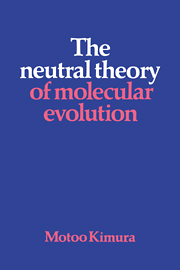Book contents
- Frontmatter
- Contents
- Preface
- Introduction
- 1 From Lamarck to population genetics
- 2 Overdevelopment of the synthetic theory and the proposal of the neutral theory
- 3 The neutral mutation-random drift hypothesis as an evolutionary paradigm
- 4 Molecular evolutionary rates contrasted with phenotypic evolutionary rates
- 5 Some features of molecular evolution
- 6 Definition, types and action of natural selection
- 7 Molecular structure, selective constraint and the rate of evolution
- 8 Population genetics at the molecular level
- 9 Maintenance of genetic variability at the molecular level
- 10 Summary and conclusion
- References
- Author Index
- Subject Index
5 - Some features of molecular evolution
Published online by Cambridge University Press: 05 August 2012
- Frontmatter
- Contents
- Preface
- Introduction
- 1 From Lamarck to population genetics
- 2 Overdevelopment of the synthetic theory and the proposal of the neutral theory
- 3 The neutral mutation-random drift hypothesis as an evolutionary paradigm
- 4 Molecular evolutionary rates contrasted with phenotypic evolutionary rates
- 5 Some features of molecular evolution
- 6 Definition, types and action of natural selection
- 7 Molecular structure, selective constraint and the rate of evolution
- 8 Population genetics at the molecular level
- 9 Maintenance of genetic variability at the molecular level
- 10 Summary and conclusion
- References
- Author Index
- Subject Index
Summary
There are several features which distinguish molecular evolution from phenotypic evolution. These features may be summarized in the form of five principles (Kimura and Ohta, 1974) as follows; the first four principles are empirical, while the last one is theoretical and helps us to understand the nature of ‘selectively neutral mutations’.
(i) For each protein, the rate of evolution in terms of amino acid substitutions is approximately constant per year per site for various lines, as long as the function and tertiary structure of the molecule remain essentially unaltered.
This is the rate-constancy hypothesis which Zuckerkandl and Pauling (1965) called the ‘molecular evolutionary clock’. This is one of the most controversial subjects in molecular evolution. Particularly, it has been debated in relation to the date of human—ape divergence (see Wilson et al., 1977), and to evidence for and against the neutral theory. I have already discussed extensively the problems relating to the constancy of molecular evolutionary rates in chapter 4, so I shall not repeat the same material here. Suffice it to say that the evidence is good in globins among mammals, although the observed variance of evolutionary rates among lines is slightly larger than what is expected by chance. There is also rough constancy of the evolutionary rates in cytochrome c and fibrinopeptides (Dickerson, 1971) although each has a different rate from that of globins (see also Table 4.1).
- Type
- Chapter
- Information
- The Neutral Theory of Molecular Evolution , pp. 98 - 116Publisher: Cambridge University PressPrint publication year: 1983
- 1
- Cited by

